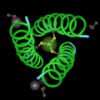Genetics textbooks abound with stories of European royalty and the hazards of having children after you've married one of your cousins. It struck me as an interesting parallel that the lion is such a popular symbol in so many royal coats of arms. Like the royal families of Europe, certain lion populations have also suffered from a few too many copies of certain recessive genes.
I first read about the Florida panthers a few years ago while researching material for a class that I teach on using bioinformatics. It wasn't my first encounter with big cats and their DNA. Years before, while teaching a class on identifying DNA sequences, I had a run in with lots of DNA sequences from large cats. To my surprise (at the time) several hundred sequences from feline leukemia viruses unexpectedly appeared in GenBank over a weekend, confounding the nice neat story that I thought my students were going to learn about sequence identification and using BLAST.
A few years later, I read a wonderful book by Stephen O'Brien, called "Tears of the Cheetah," and learned more about this amazing story. I had hoped that the current status of the Florida panther would make this saga a perfect fit for the Ask A Science Blogger question of the week on the unsung successes of using science to guide policy. As you will learn, through, it's only been a partial success.
Let the tale begin.
In the 1960's, Floridians became concerned that the famous Florida panther was on it's way out. As the numbers of cats dropped, Fish and Game officials, concerned individuals, and environmental groups debated the best course of action. A popular cat, and the state animal of Florida, several agencies and media personnel gathered like vultures in 1992 to oversee and report on the population's collapse.
At issue were three distinctive physical characteristics that seemed to say "this is a separate species." Unlike other big cats, Florida panthers had a funny kink in their tails and a cowlick on the back of their neck. They also had white flecks of fur on their backs, close to where their neck met their shoulders.
In 1986, Melody Roelke and Stephen O'Brien started looking at the genetic diversity of the Florida panthers. DNA told the tale. With up to 94% of the panther sperm cells malformed, the panthers were in trouble. Further, many panthers had a hereditary condition where one or more testicles fail to descend. Many panthers were also plagued by inherited defects in the atrial valve of the heart and problems with infectious disease. Population bottlenecks and hard times in the panther's history left the Florida panthers with too little genetic diversity.
It was clear to the geneticists that the panthers needed new blood if they were to survive.
But not everyone agreed.
As Stephen O'Brien put it:
Left alone, the Florida panther would be remembered as a textbook exercise in how to go extinct while your abundant and vociferous advocates argue about the process.
To cut to the chase, the Florida panthers did get some "new blood" via some imported Texas cats. And, the more visible hallmarks of inbreeding are starting to disappear. This graph, from the Florida Fish and Wildlife department's 2004-2005 report shows that the proportion of panthers with kinked tails has dropped to 30% from a high of 80% (2).

Genetically, this experiment has been a success because all the evidence shows the cats are healthier. But the numbers of panthers are still lower than they need to be in order to consider the story closed. It may be a long time before the chapter about long-term survival of the Florida panther can be written.
References:
1. Stephen J. O'Brien. Tears of the Cheetah. Thomas Dunne Books, NY. 1993.
2. Florida Fish and Wildlife Conservation Commission. The Florida Panther Annual Report, 2004-2005.
3. Beier, P., M. Vaughan, M. Conroy, and H. Quigley. 2003. An Analysis of Scientific Literature Related to the Florida Panther. Bureau of Wildlife Diversity Conservation, Florida Fish and Wildlife Conservation Commission.
technorati tags: cats, panthers, conservation biology, biology, genetics, population genetics, DNA

ionolsen21 Your site is very cognitive. I think you will have good future.:)